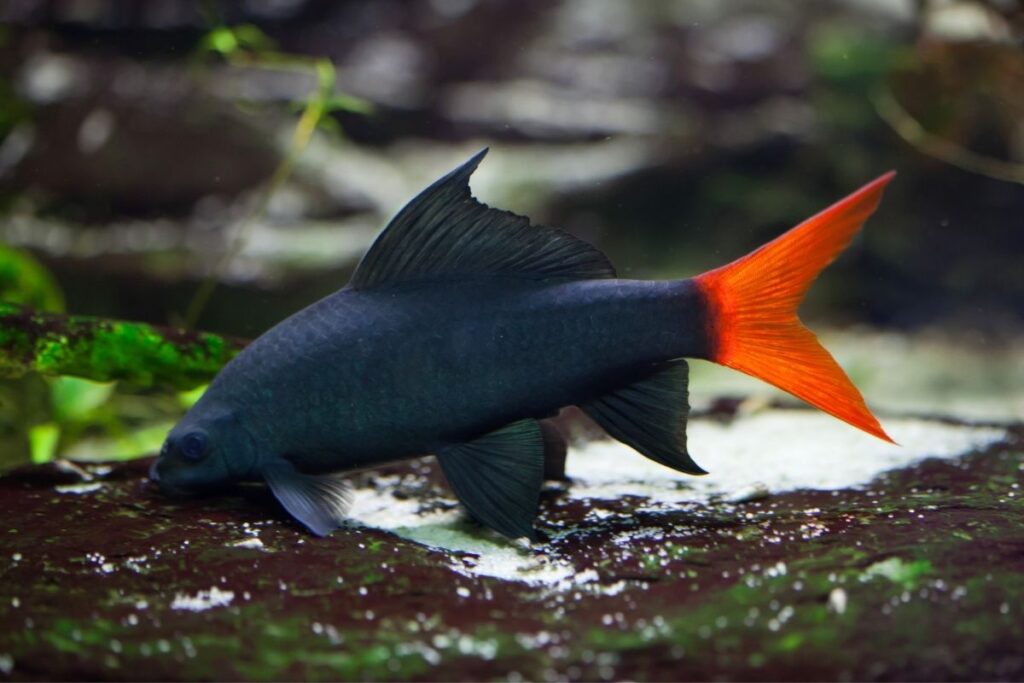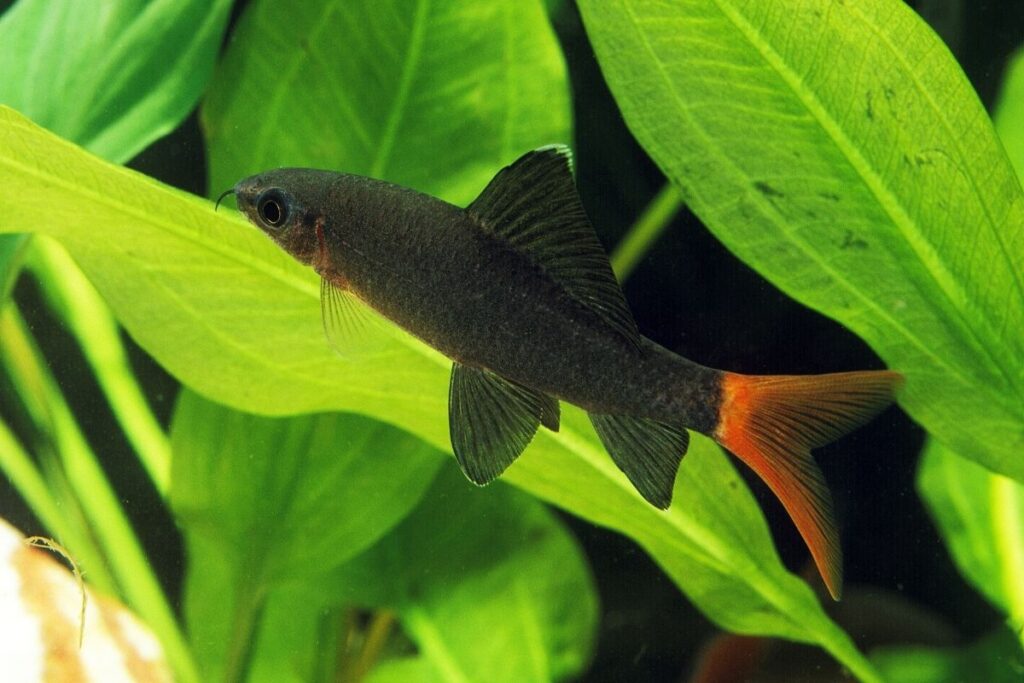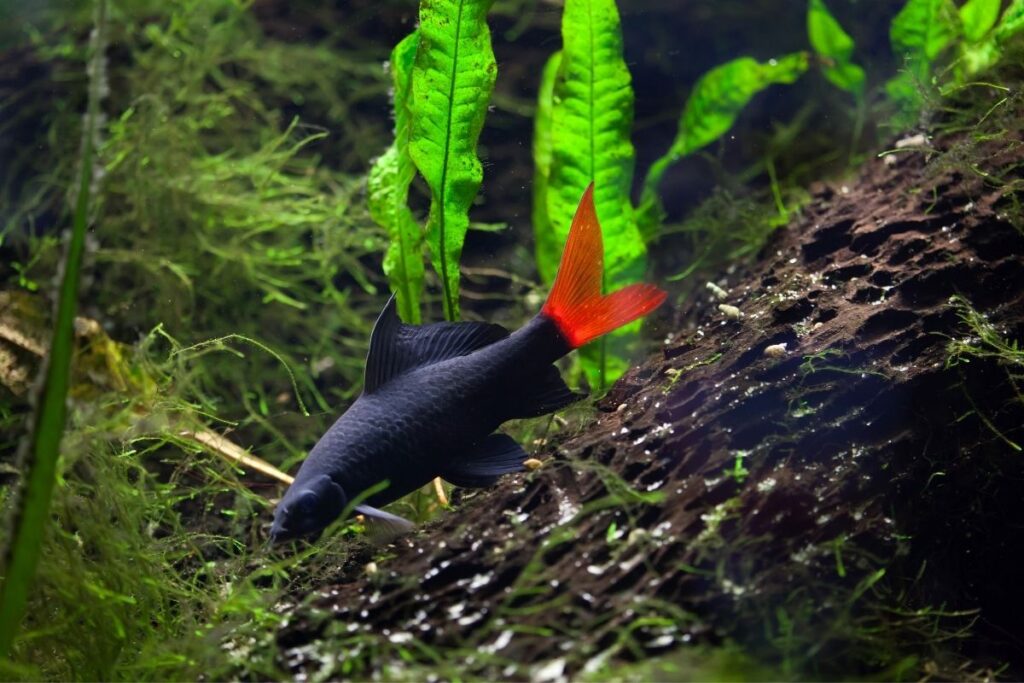If you’re looking for an eye-catching addition to your aquarium, you might want to consider the Redtail Shark. These beautiful fish are known for their vibrant red tails and sleek, black bodies. But before you bring one home, it’s important to understand what they need to thrive in their new environment.
Redtail sharks require a well-maintained aquarium with suitable water conditions, a varied diet, and a peaceful environment. They need a pH range of 6.5-7.5 and a temperature range between 72-79°F. The aquarium should be planted, and regular water changes should be performed to ensure their health. They are territorial and can be aggressive towards other fish, making them best suited for species-only tanks.
In this article, I’ll cover everything you need to know about Redtail Shark care, from the ideal tank setup to their dietary requirements. Whether you’re a seasoned fish owner or a beginner, you’ll find valuable information to help you keep your Redtail Shark healthy and happy.
As someone who has owned Redtail Sharks in the past, I can attest to their unique personality and striking appearance. However, they do require specific conditions to thrive, and it’s important to be prepared before bringing one home. In the following paragraphs, we’ll explore the key aspects of Redtail Shark care to help you provide the best possible environment for your new aquatic friend.

Table of Contents
Species Summary
If you’re thinking about adding a Redtail Shark to your aquarium, it’s important to understand the species summary. Here’s what you need to know:
Origin
The Redtail Shark, also known as the Redtail Black Shark, is native to Thailand and Cambodia, where it lives in slow-moving rivers and streams.
Lifespan
With proper care, a Redtail Shark can live up to 8 years in captivity. However, it’s important to note that their lifespan can be significantly shortened if they are not given the right environment or diet.
Appearance
Redtail Sharks are known for their striking appearance. They have a sleek, black body with a bright red tail fin, which is where they get their name. They also have a pointed snout and sharp teeth.
Size
Redtail Sharks can grow up to 6 inches in length, making them a relatively small species of fish.
Growth rate
The growth rate of Redtail Sharks can vary depending on a number of factors, including their environment and diet. Generally, they will grow to their full size within 1-2 years.
Behavior & Temperament
Redtail Sharks are known for their aggressive behavior, especially towards other fish.
It’s important to give them plenty of space in the aquarium and to avoid keeping them with other territorial fish. However, they can be kept with other non-aggressive species.
Personally, I have had a Redtail Shark in my aquarium for over a year now and have found it to be a fascinating and captivating addition to my tank.
Its striking appearance and unique behavior always catch my eye, and I have enjoyed watching it grow and thrive in its environment.
Habitat and Tank Requirements
Tank Size
The Redtail Shark is a territorial fish that requires ample space to swim around. A minimum tank size of 50 gallons is recommended for a single Redtail Shark.
If you plan to keep more than one, add 20 gallons for each additional fish. A larger tank will also help maintain stable water conditions.
Lighting
Redtail Sharks prefer dimly lit environments, so avoid bright lighting.
Use low to moderate lighting to mimic their natural habitat. A timer can be helpful to ensure consistent lighting conditions.
Filtration
A good filtration system is essential for maintaining a healthy and clean environment for your Redtail Shark.
A canister filter or a hang-on-back filter is recommended, with a turnover rate of at least 5 times the tank volume per hour. Regular maintenance of the filter is also necessary to keep it functioning properly.
Aeration
Redtail Sharks require well-oxygenated water, so aeration is important. A simple air stone or a powerhead can be used to increase water movement and oxygenation.
Heater
Redtail Sharks are tropical fish and require a water temperature between 72-79°F. Use a reliable heater to maintain a consistent temperature. A thermometer is also recommended to monitor the water temperature.
Substrate
A fine-grained sand substrate is recommended for Redtail Sharks. Avoid using sharp or rough substrates that can damage their delicate barbels.
Decorations
Redtail Sharks are territorial and enjoy having hiding places. Use driftwood, rocks, and caves to create a natural environment and provide hiding places for your Redtail Shark.
Plants
Redtail Sharks are known to uproot plants, so choose hardy plants that can withstand their behavior. Java fern, Anubias, and Amazon swords are good choices. Floating plants can also be used to provide cover and shade.

When I first got my Redtail Shark, I made the mistake of keeping it in a small tank with bright lighting.
It became stressed and aggressive, and I had to upgrade to a larger tank with a dimmer environment.
Since then, I’ve learned that Redtail Sharks require specific tank conditions to thrive, and I’m happy to provide them with a comfortable and healthy home.
Water Quality
Keeping the water quality in your Redtail Shark’s tank is crucial to their health and well-being. Here are a few key factors to consider:
Water Temperature
The ideal water temperature for Redtail Sharks is between 72-79°F (22-26°C). I personally keep my Redtail Shark’s tank at 76°F (24°C) as I have found this to be the sweet spot for them.
It’s important to maintain a consistent temperature, so investing in a good quality heater is essential.
Water pH
Redtail Sharks prefer a slightly acidic to neutral pH level, between 6.5-7.5. It’s important to regularly test the pH level of your tank and make adjustments as necessary.
Adding driftwood or almond leaves to the tank can help lower the pH level naturally.
Water Hardness
Redtail Sharks prefer moderately hard water, with a hardness level between 5-15 dGH.
If your water is too soft, adding crushed coral or limestone to your tank can help increase the hardness level.
Conversely, if your water is too hard, adding peat moss or almond leaves can help lower the hardness level.
Water Changes
Performing regular water changes is essential to maintaining good water quality in your Redtail Shark’s tank. I recommend changing 20-30% of the water every 1-2 weeks.
This helps remove any excess waste or toxins that may have accumulated in the tank. Make sure to use a good quality water conditioner to remove any chlorine or chloramine from the tap water.
In conclusion, maintaining good water quality is crucial to the health and well-being of your Redtail Shark.
By keeping an eye on the water temperature, pH level, hardness level, and performing regular water changes, you can ensure that your fish is happy and healthy for years to come.
Feeding
Diet
Redtail Sharks are omnivores and require a varied diet to maintain their health.
They will eat almost anything, including flakes, pellets, frozen foods, and live foods.
When it comes to flakes and pellets, it’s important to choose high-quality brands that contain a good balance of protein and other nutrients.
I have found that my Redtail Shark particularly enjoys Hikari Micro Pellets.
In addition to prepared foods, you can also offer your Redtail Shark live and frozen foods such as bloodworms, brine shrimp, and daphnia.
These foods provide important nutrients and can also help stimulate natural hunting behaviors.
Feeding Schedule
It’s important to establish a regular feeding schedule for your Redtail Shark. I personally feed my Redtail Shark twice a day, once in the morning and once in the evening.
When feeding, it’s important to only offer what your fish can consume in a few minutes, as overfeeding can lead to health problems and water quality issues.
I like to use a small feeding dish to ensure that excess food doesn’t fall to the bottom of the tank.
Remember to also vary the type of food you offer your Redtail Shark to ensure a balanced diet.
Overall, providing a varied and balanced diet on a regular feeding schedule is key to maintaining the health and happiness of your Redtail Shark.
Behavior and Temperament
Redtail Sharks are known for their active and playful nature. They are curious and love to explore their surroundings. They are also territorial and can be aggressive towards other fish.
Aggression
Redtail Sharks are known to be aggressive towards other fish, especially those that are similar in size and color. They are territorial and will defend their space against intruders.
It is important to provide them with enough space to establish their territory and avoid overcrowding in the tank.
Compatibility
Redtail Sharks are not compatible with all fish species. They should not be kept with slow-moving or long-finned fish, as they may mistake them for prey.
They are best kept with other active and robust fish species that can hold their own against the Redtail Shark.
Tank Mates
Good tank mates for Redtail Sharks include other bottom-dwelling fish, such as Corydoras and Loaches. They can also be kept with other active fish species, such as Rainbowfish and Gouramis.
However, it is important to avoid keeping them with aggressive fish or those that are similar in size and color.
Hiding Spots
Redtail Sharks need plenty of hiding spots in the tank to establish their territory and feel secure. You can provide them with caves, rocks, and plants to create hiding spots.
It is important to ensure that these hiding spots are big enough for the Redtail Shark to fit into comfortably.
How many Redtail Sharks can live together?
Redtail Sharks are best kept alone or in pairs. Keeping more than two Redtail Sharks in the same tank can lead to aggression and territorial disputes.
It is important to provide enough space for each Redtail Shark to establish its own territory.
Personally, I have kept Redtail Sharks in the past and found them to be fascinating fish. Their active and playful nature always kept me entertained, and their territorial behavior added an interesting dynamic to the tank.
However, I learned the hard way that they should not be kept with slow-moving or long-finned fish. I made the mistake of keeping them with a school of Angelfish, and they ended up attacking and killing them.
It was a tough lesson to learn, but it taught me the importance of researching fish compatibility before adding them to the tank.
Health and Disease
As with any pet, it’s important to keep your Redtail Shark healthy and prevent diseases. Here are some tips on how to do just that:
Common Diseases
Redtail Sharks are generally hardy fish, but they can still fall victim to common diseases such as:
- Ich: A parasitic disease that causes white spots on the fish’s body.
- Fin rot: A bacterial infection that causes the fins to deteriorate.
- Velvet disease: A parasitic disease that causes a gold or rust-colored dust on the fish’s body.
Prevention
The best way to prevent diseases is to provide your Redtail Shark with a clean and healthy environment. Here are some tips:
- Perform regular water changes to keep the water clean and clear.
- Ensure the temperature and pH levels are appropriate for your fish.
- Feed your fish a balanced diet and avoid overfeeding.
Treatment
If your Redtail Shark does fall ill, it’s important to act quickly to prevent the illness from spreading to other fish in the tank. Here are some treatment options:
| Disease | Treatment |
|---|---|
| Ich | Medications such as copper sulfate or malachite green can be used to treat ich. |
| Fin rot | Antibiotics such as tetracycline can be used to treat fin rot. |
| Velvet disease | Medications such as copper sulfate or formalin can be used to treat velvet disease. |
Remember to always follow the instructions on the medication carefully and remove any activated carbon from the filter before treatment.
Personally, I learned the hard way about the importance of prevention when I lost a Redtail Shark to fin rot. After doing some research, I realized that I wasn’t doing enough to keep the water clean and clear. Since then, I’ve been diligent about performing regular water changes and ensuring the temperature and pH levels are appropriate for my fish. It’s been smooth sailing ever since!
Signs of a Healthy Red Tail Shark
As an aquarium owner, it’s important to be able to recognize the signs of a healthy red tail shark. Here are a few things to look out for:
- Bright Colors: A healthy red tail shark will have bright and vibrant colors. The red tail should be a deep red color, and the body should be black.
- Active Behavior: A healthy red tail shark will be active and swim around the aquarium. If your red tail shark is lethargic or spends a lot of time hiding, it may be a sign of illness.
- Clear Eyes: The eyes of a healthy red tail shark should be clear and free of any cloudiness or discoloration.
- Healthy Fins: The fins of a healthy red tail shark should be intact and free of any tears or damage.
Personally, I have found that the best way to ensure the health of my red tail shark is to maintain a clean and well-filtered aquarium. Red tail sharks are sensitive to poor water conditions, so it’s important to keep the water clean and free of any harmful chemicals or pollutants.
I also make sure to feed my red tail shark a balanced diet of high-quality fish food and occasional treats like live or frozen brine shrimp.
By keeping an eye out for these signs of a healthy red tail shark and providing proper care, you can enjoy the beauty and personality of this unique fish for years to come.
Signs of a Sick Red Tail Shark
If you own a Red Tail Shark, you will want to keep an eye out for any signs of illness. Here are some common symptoms to look out for:
- Loss of appetite – If your Red Tail Shark is not eating or showing any interest in food, it could be a sign of illness.
- Erratic swimming behavior – If your Red Tail Shark is swimming frantically or erratically, it could indicate a problem.
- Discoloration – If your Red Tail Shark’s colors appear faded or dull, it could be a sign of illness or stress.
- Visible signs of injury or disease – Keep an eye out for any visible wounds or signs of disease, such as white spots or fungus growth.
If you notice any of these symptoms, it is important to take action quickly. Sick fish can deteriorate rapidly, and prompt treatment is essential to prevent the spread of disease to other fish in your tank.
When I first got my Red Tail Shark, I noticed that it was hiding a lot and not coming out to eat. After doing some research, I realized that this behavior could be a sign of stress or illness.
I immediately checked the water parameters in my tank and found that the pH was too low. After adjusting the pH and adding some stress coat to the water, my Red Tail Shark started to come out more and eat normally again.
Breeding Redtail Sharks
Mating
Redtail sharks are egg layers, and breeding them can be quite challenging. To breed them, you need to have a male and a female that are mature enough.
The male will typically chase the female around the tank, and when he is ready to mate, he will try to nudge the female towards a suitable location. The female will lay her eggs, and the male will fertilize them.
Signs of Pregnancy

It can be tricky to tell if a female redtail shark is pregnant or not. One of the signs to look out for is a distended belly.
However, this can also be a sign of overfeeding, so it’s essential to monitor your fish’s diet carefully.
Another sign is if the female is acting more aggressively than usual, which can indicate that she is protecting her eggs.
Fry Care
Once the eggs have been fertilized, they will hatch within 48-72 hours. The fry will be very small and delicate, so it’s essential to provide them with a suitable environment.
You can feed them with infusoria or brine shrimp, but make sure not to overfeed them. It’s also crucial to keep the water clean and maintain stable water conditions to ensure the fry’s survival.
When I first tried breeding my redtail sharks, I was excited to see the eggs hatch. However, I quickly realized that fry care can be quite challenging.
I made the mistake of overfeeding them, which led to poor water quality and the death of most of the fry.
I learned that breeding redtail sharks requires patience, attention to detail, and a lot of research.
Recommended Products:
- NICREW ClassicLED Aquarium Light – This low to moderate lighting LED light is perfect for Redtail Sharks, as they prefer dimly lit environments.
- Fluval 407 Performance Canister Filter – This canister filter has a high turnover rate and is recommended for maintaining good water quality in Redtail Shark tanks.
- Hygger Aquarium Air Stone Kit – This kit provides gentle water movement and aeration, which is important for Redtail Sharks.
- Eheim Jager Aquarium Thermostat Heater – This reliable and accurate heater helps maintain the correct temperature for Redtail Sharks.
- CaribSea Super Naturals Aquarium Sand – This fine-grained sand substrate is recommended for Redtail Sharks, as it is gentle and won’t damage their barbels.
- Penn-Plax Aquarium Decoration – This aquarium decoration provides hiding places and visual interest for Redtail Sharks.
- Java Fern – This live plant provides a natural source of oxygen and helps maintain water quality. Redtail Sharks also enjoy resting on the broad leaves.
- Hikari Micro Pellets – These high-quality pellets are a great staple for Redtail Sharks and provide a balanced diet.
- API Aquarium Water Test Kit – This water quality test kit allows you to monitor the pH, hardness, and other parameters of your tank water, ensuring that it is within the ideal range for Redtail Sharks.
Conclusion
Caring for a Redtail Shark can be a rewarding experience for any aquarium enthusiast. These beautiful fish are full of personality and add a unique element to any tank. However, it is important to remember that they require specific care in order to thrive.
By following the guidelines outlined in this article, you can ensure that your Redtail Shark is healthy and happy. Remember to provide them with plenty of space, a well-maintained tank, and a balanced diet. Additionally, consider adding some hiding spots and plants to create a more natural environment for your fish.
It is also important to note that Redtail Sharks can be territorial and aggressive towards other fish. As I learned from personal experience, it is best to keep them in a species-only tank or with other fish that are similar in size and temperament.
Overall, with the right care and attention, a Redtail Shark can be a beautiful and fascinating addition to any aquarium. Happy fish-keeping!
FAQs
Now that you know everything about Redtail Shark care, let’s answer some frequently asked questions:
Q: Can I keep Redtail Sharks with other fish?
A: Yes, you can keep Redtail Sharks with other fish as long as they are not too small or slow-moving. Avoid keeping them with peaceful fish like tetras or guppies, as the Redtail Shark may become aggressive towards them. It’s best to keep them with other semi-aggressive fish like barbs or cichlids.
Q: How often should I feed my Redtail Shark?
A: Redtail Sharks are omnivorous and will eat almost anything, but it’s important to feed them a balanced diet. Feed them once or twice a day, and make sure to include both plant-based and meat-based foods. You can feed them flakes, pellets, frozen or live foods like brine shrimp or bloodworms.
Q: How big do Redtail Sharks get?
A: Redtail Sharks can grow up to 6 inches in length, so it’s important to provide them with a tank that is at least 55 gallons. They are active swimmers and need plenty of space to move around.
Q: Can Redtail Sharks live with plants?
A: Yes, Redtail Sharks can live with plants, but they may uproot or eat them. It’s best to choose hardy plants like Java fern or Anubias that can withstand their activity.
Personal Anecdote: I once had a Redtail Shark that was very aggressive towards my peaceful tetras. I had to rehome the tetras to keep them safe, but my Redtail Shark thrived with his new tank mates, a group of barbs. It’s important to choose tank mates carefully to ensure everyone gets along.
Reference: Wikipedia.
